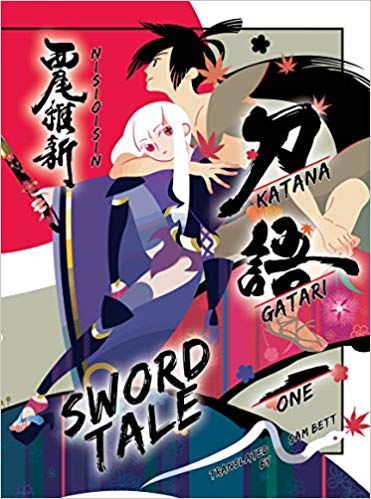By Nisioisin and take. Released in Japan in three separate volumes by Kodansha BOX. Released in North America by Vertical, Inc. Translated by Sam Bett.
This is the third major series of Nisioisin’s to come out over here as a novel, after the popular Monogatari Series and the cult classic but poor selling Zaregoto Series. These books reunite Nisio with the artist for the Zaregoto books, and the art is sufficiently stylistically awesome. As for fans of Nisioisin’s wordplay, not only do they get tons of that in these volumes, but we get footnotes from the translator (which he indicates are totally optional) explaining many of the original lines and why they’re puns, as well as his own translation choices. It’s the sort of thing I wish that we could have seen with the Monogatari books, as it might have made several readers less dagnabbit mad. The book is also very metatextual, a common thread in Nisio’s work, with suggestions that certain elements will be followed up with in future books, or announcing the tragic backstory of one of the characters is coming. That said, it’s a very Nisio series, but how does it hold up as an actual book?
Our hero is Shichika, who lives on a little-known island with his older sister Nanami. He’s the heir to a school of swordsmanship, the Kyotoryu, that does not use swords – but aside from not using swords, it’s handled exactly like a classic sword school. As a result, Shichika is essentially a blade himself, which makes sense given that sometimes he tends to have the emotional depth of an inanimate object. Into this island steps Togame, who is there to hire Shichika to help her locate twelve Mutant Blades, katanas that rightfully should belong to the Shogun but are instead being used by twelve other people. After the events of the first book, which involve the first of those swords, Shichika agrees to accompany her, leaving the island and his sister and going to get each sword one by one – though that always means a battle.
As I hinted before, Shichika is almost a parody of the “simple country bumpkin’ type who isn’t so simple, and much is made of the fact that he has never really had to think before now, so isn’t used to it. This makes him a pleasing contrast at least to super-genius Ii-chan and overly florid Araragi. He’s fine with leaving the thinking to Togame, who is a self-titled “schemer” but whose schemes haven’t really been able to do much but postpone the inevitable fights so far, and whose fragility makes her easy to use as a hostage or a distraction. She’s also less clever than she thinks, as the best gag in the book, a misuse of a British greeting she has, attests to. Together they make each other more interesting, which is all one can ask. As for the sword wielders, by the end of the first omnibus three are dead, though you are only meant to feel sympathy for the last one – indeed, the ninja clan that start the book as the main antagonists have become, at the author’s own insistence, the comic foils of the story.
It’s clear who this book is meant for: fans of the anime, as well as fans of Nisioisin’s eclectic narrative style. Both should find this series very entertaining, though even I found Shichika somewhat wearing by the end. I’ll definitely be getting the next set of three this spring.

